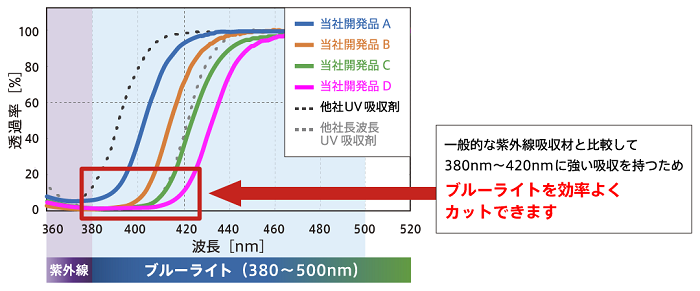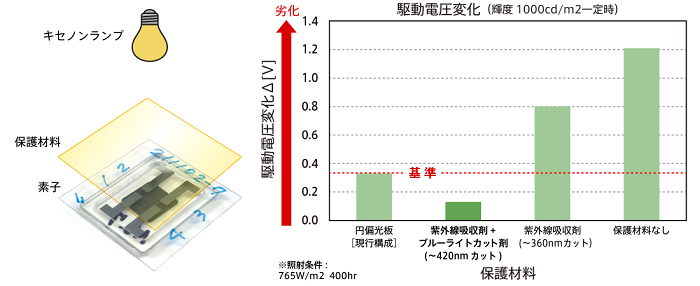Business/Products
TOYOCOLOR CO., LTD.
Demonstration that blue light accelerates the deterioration of organic EL displays
- Momentum for extending the lifespan of organic EL displays and expanding the use of foldable/rollable terminals without circularly polarizing plates -
TOYOCOLOR CO., LTD. (President and Representative Director Okaichi, Chuo-ku, Tokyo) has demonstrated that it is possible to suppress the deterioration of organic EL displays by protecting them from blue light. By using a blue light cutting agent developed by our company to cut wavelengths from 380 to 420 nm, it is possible to extend the lifespan of organic EL displays.
Organic EL displays are increasingly being used in high-end smartphones and televisions due to their high image quality, but the durability of the blue pigment in particular is low and the image quality deteriorates over time, making the product more difficult to use than LCD displays. It is said to have a short lifespan. Factors that cause deterioration of organic EL devices include repeated light emission by the device and ultraviolet rays, and various countermeasures have been taken to date. The effects of blue light were also assumed to be one of the factors contributing to the deterioration, but this had not been proven until now, partly because there was no suitable blue light blocking agent that could be put into practical use.
TOYOCOLOR has collaborated with Associate Professor Toshihisa Yuki of the Yamagata University Organic Electronics Innovation Center (https://inoel.yz.yamagata-u.ac.jp/), a cutting-edge experimental research institution in the field of organic electronics. We demonstrated the effect of blue light on organic EL devices. By protecting the organic EL element using our blue light cutting agent, it is possible to suppress the voltage rise by approximately 60% compared to the current configuration.
This is expected to extend the lifespan of organic EL displays, and also enable use in automotive applications and outdoor signage, which require durability in harsher usage environments. Furthermore, since deterioration can be sufficiently suppressed even without a circularly polarizing plate (*1), the use of foldable/rollable terminals is expected to expand.
By leveraging our elemental technologies of synthesis technology and dispersion technology, TOYOCOLOR continues to propose solutions to social issues with functional materials, thereby contributing to improving the appeal of our customers' products and contributing to the evolution of displays for the future. We will continue to contribute to the creation of a new lifestyle culture.
About blue light and our blue light cutting agent
Blue light (380-500nm) has a short wavelength among visible light rays and has relatively strong energy. It is widely known that ultraviolet light (~380nm) degrades organic materials, but it is beginning to be pointed out that blue light also degrades materials in the same way as ultraviolet light.

The highly resistant blue light cutting agent developed by TOYOCOLOR is a new material with excellent blue light cutting performance due to its unique structure based on synthetic technology cultivated over many years. It is possible to add blue light cutting function by adding a small amount, and it is also possible to arbitrarily control the blue light cutting range within a certain range according to your request. It has very high light and heat resistance and does not deteriorate over a long period of time, making it suitable for use in durable goods.We also have a lineup of products that can withstand temperatures as high as 350℃, allowing them to be used in processing processes and harsh usage conditions that were previously unusable. Available for use.

■ TOYOCOLOR related website
高耐性ブルーライトカット剤
https://www.toyo-color.com/ja/products/pickup/blue-light-cut_masterbatch.html
About the influence of blue light on organic EL devices
Generally, as organic EL elements deteriorate, the driving voltage required to obtain the same brightness increases. In order to compare the deterioration of the elements due to different protective materials, we protected each blue organic EL element using a circularly polarizing plate, a general-purpose ultraviolet absorber, and a blue light cutting agent, and conducted a light resistance test. The device fabrication and degradation evaluation were conducted with the cooperation of Associate Professor Toshihisa Yuki, Yamagata University Organic Electronics Innovation Center.
As a result of this experiment, we found that by protecting the circularly polarizing plate used in current organic EL displays with an ultraviolet absorber and a blue light cut agent, the drive voltage of the organic EL element could be increased by approximately 60% compared to the current configuration. %, demonstrating that deterioration can be sufficiently suppressed even without a circularly polarizing plate. It is expected to contribute to extending the lifespan of the CoE (Color Filter on Encapsulation) structure (*2), which is attracting attention in foldable/rollable devices.

1 Circular polarizing plate: Used in organic EL displays, it plays the role of canceling out the reflection of external light that enters the display.
2 CoE (Color Filter on Encapsulation) structure: Anti-reflection technology that replaces circularly polarizing plates.
TOYOCOLOR and the TOYOCOLOR logo are trademarks or registered trademarks of TOYO INK SC Holdings Co., Ltd.
###
Inquiries
TOYOCOLOR CO., LTD.
Functional materials sales department
Person in charge: Saito, Usui
TEL: +81-3-3272-0956
Press inquiries
TOYO INK SC HOLDINGS CO., LTD.
Corporate Communication Department
TEL: +81-3-3272-5720
MAIL: info@toyoinkgroup.com

Adobe Reader is required to view PDF files.
